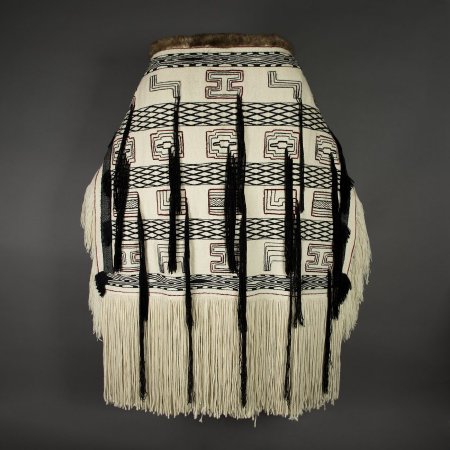Description:
Mother Robe, 1991
Various weavers, design by Delores Churchill
The Mother Robe is one of the first Ravenstail ceremonial robes to be made in modern times. The work was done in sections by over 80 weavers from Ketchikan, Kake, Metlakatla, Hoonah, Juneau, White Horse, Sitka and Nass River, British Columbia, who contributed 1150 hours to complete the project.
Ravenstail robes predate Chilkat weaving and differ from the latter style in a number of ways, most notably in color and design. The Chilkat style allows the curving formline design, representing clan crests, to be worked into the pattern. Ravenstail twining technique is limited to geometric patterns which are similar to spruce root basketry. Knowledge about the style was limited due to the rarity of original examples. Only eleven known ancient robes or fragments are found in collections. The earliest written observation of a robe dates from 1774; by the 1800s, Ravenstail was no longer being made.
The revival of the Ravenstail style was spearheaded by weaver Cheryl Samuels from an intensive study of the existing fragments. After deciphering the technique and publishing the information in 1987, she began teaching the skill. The Mother Robe, dedicated in 1991, was the result of a symposium sponsored by Ketchikan Museums and the Ravenstail Weaver's Guild, led by Samuels.
The Mother Robe combines traditional and contemporary design elements. Designs from basketry and Ravenstail were used, such as kaa jikóol kajóolani (old person back of hand tattooed) and the cross-hatch design. The inclusion of red accents rather than yellow was one contemporary idea. Others were the new designs created and named by the weavers, such as "ebbing tide", "mother river" and "looking from the top of the mountain." The upper and lower border design represent the weavers joining hands and is named "weavers of the past, present, and future." It is woven with thigh-spun warp and commercially spun weft in Merino sheep wool, trimmed on top in sea otter, four bands of designs, with three bands of design on black. Fringe on sides and bottom. The design is in white, black, yellow and red - "the color of all races."
Ravenstail robes predate Chilkat weaving and differ from the latter style in a number of ways, most notably in color and design. The Chilkat style allows the curving formline design, representing clan crests, to be worked into the pattern. Ravenstail twining technique is limited to geometric patterns which are similar to spruce root basketry. Knowledge about the style was limited due to the rarity of original examples. Only eleven known ancient robes or fragments are found in collections. The earliest written observation of a robe dates from 1774; by the 1800s, Ravenstail was no longer being made.
The revival of the Ravenstail style was spearheaded by weaver Cheryl Samuels from an intensive study of the existing fragments. After deciphering the technique and publishing the information in 1987, she began teaching the skill. The Mother Robe, dedicated in 1991, was the result of a symposium sponsored by Ketchikan Museums and the Ravenstail Weaver's Guild, led by Samuels.
The Mother Robe combines traditional and contemporary design elements. Designs from basketry and Ravenstail were used, such as kaa jikóol kajóolani (old person back of hand tattooed) and the cross-hatch design. The inclusion of red accents rather than yellow was one contemporary idea. Others were the new designs created and named by the weavers, such as "ebbing tide", "mother river" and "looking from the top of the mountain." The upper and lower border design represent the weavers joining hands and is named "weavers of the past, present, and future." It is woven with thigh-spun warp and commercially spun weft in Merino sheep wool, trimmed on top in sea otter, four bands of designs, with three bands of design on black. Fringe on sides and bottom. The design is in white, black, yellow and red - "the color of all races."
Ketchikan Museums, KM 96.2.67.1 EDUC

